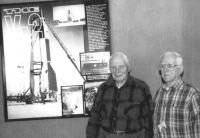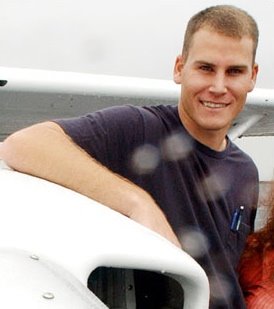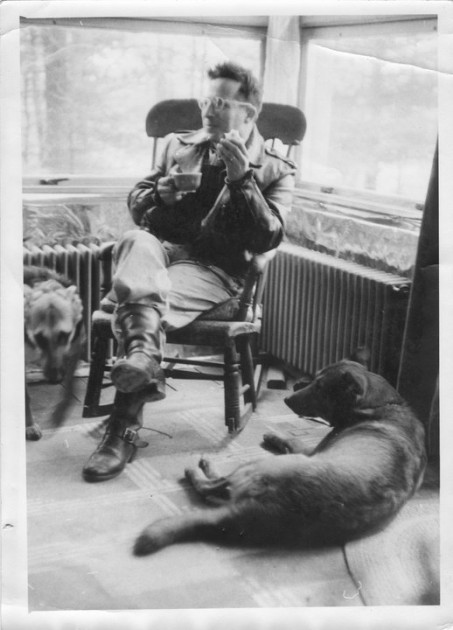Alex Constantine - August 2, 2010
By Michael Shinabery
Alamogordo Daily News | August 1, 2010
 The German army conscripted Konrad Dannenberg in 1939, assigned him to "a horse-drawn company" and sent him to France, the Web site timesonline.co.uk reported.
The German army conscripted Konrad Dannenberg in 1939, assigned him to "a horse-drawn company" and sent him to France, the Web site timesonline.co.uk reported.
The next year, the military discharged him "as unsuitable for riding horses."
With a master's degree in mechanical engineering, however, his knowledge of rocketry was considered essential and Peenemunde recruited him. At the German military's secret facility along the Baltic Coast, he set about refining the V-2 rocket's "engine efficiency," the Web page nytimes.com said.
Dannenberg told Forbes magazine in 2007, two years before he died at age 96, that his life had been filled with "great adventures." And, while he never achieved the dream of personally flying in space, his expertise sent others there.
"Dannenberg spent his life imagining and creating ways for humanity to take to the stars," the Web site nasa.gov said.
Dannenberg was born on Aug. 5, 1912, in Saxony, Germany coincidentally the same date Neil Armstrong, the first man on the moon, was born on in 1930. He was "fascinated by space technology at an early age," said timesonline.co.uk. Carmaker Fritz von Opel, who "constructed the first rocket-powered car engine in 1928," inspired him; as did Max Valier, "an Austrian amateur rocketeer (and science writer) who campaigned for the use of rockets for space flight."
"He caught the space bug while attending a (Valier) lecture," said the Web site astronautix.com.
"Our goal was to go to Mars," Dannenberg told Forbes. "After all, the moon is only part of the Earth's system, not another planet. We wanted to go to the next planet."
At university, Dannenberg studied "the injection of diesel fuel into engines," and at Peenemunde as director of rocket motor development, his "first task was to study the injection system of rocket engines," timesonline.uk documented.
"In those days," said nasa.gov, "igniting rocket engines posed a big problem because most blew up at the time of ignition. Dannenberg became a specialist and ultimately designed the mixing nozzles of a working combustion chamber" for V-1s and V-2s.
Dannenberg immigrated to the United States under Operation Paperclip, joining such notable scientists as Wernher von Braun. He arrived on Nov. 16, 1945, stated a formerly classified document: "Ordnance Research and Development Division Suboffice (Rocket) Fort Bliss, Texas." On March 1, 1947, his wife, Ingeberg, and their son, Klaus, then 2 years old, joined him.
"We did not know what was ahead of us," Dannenberg told Forbes. "In Germany, practically everything was kaput. For me, there was no question that I would join von Braun, leave that damaged country and come to the States. By the time the war ended, we were in southern Germany, not in Peenemunde. The Russians were greatly disappointed not to find us there."
"In January 1947, Dannenberg and the other rocket engineers worked tirelessly at Fort Bliss, Texas, designing, building and testing rocketry systems," nasa.gov said. "The test launches took place at the White Sands Proving Ground in New Mexico."
Two years later, the U.S. Army relocated the Paperclip scientists to Huntsville, Ala. There, they built Explorer 1, launched in early 1958 in response to the Soviet Union's Sputnik, as well as the Redstone rocket that boosted Mercury astronauts. In 1960, Dannenberg joined NASA, "what would prove to be the space race's winning team," timesonline.co.uk said
"Dannenberg found himself at the heart of an immense effort of development under von Braun, as a result of which the first manned Saturn V sent the Apollo 8 astronauts into orbit around the moon in December 1968," the site said.
The military had "conceived" the Saturn "as a long-range military ballistic rocket and a satellite launcher," timesonline.uk said. However, after the Soviet Union launched Yuri Gagarin, and President John F. Kennedy responded by committing America to putting a man on the moon first, "the search for a rocket to accomplish this took on a new urgency." The Saturn "won out."
"It was a massive undertaking," Dannenberg told Forbes. "Our real job was to tell contractors what we needed, open it up for bids and evaluate who we thought would be best. Headquarters did not always agree with our conclusions. Some decisions were politically oriented."
In addition to his various NASA positions, including program manager of the International Space Station, Dannenberg was associate professor of aerospace engineering at the University of Tennessee Space Institute in Tullahoma. He retired from NASA in 1973, and a year before he died was still "a consultant to the U.S. Space & Rocket Center in Huntsville," Forbes said. He still hoped to see a Mars expedition and called for an "international effort."
According to Forbes, the Ares rocket engine, designed to lift post-space shuttle astronauts to the International Space Station, is "a descendant of the engine Konrad Dannenberg designed for the Saturn V."
"His fingerprints are all over it," Stephen Cook, NASA's Exploration Launch Projects Office director, said in Forbes.
Dannenberg also supported space tourism because "it might encourage additional people to come up with new ideas," he said. Burt Rutan, who won the $10 million X-Prize in 2004 with SpaceShipOne, offered Dannenberg a seat on a future flight. Dannenberg pointed out to Forbes, though, that being 95 and suffering arthritis made the trip virtually implausible.
Michael Shinabery is an education specialist and Humanities Scholar with the New Mexico Museum of Space History. E-mail him at michael.shinabery@state.nm.us.
http://www.alamogordonews.com/ci_15650848







